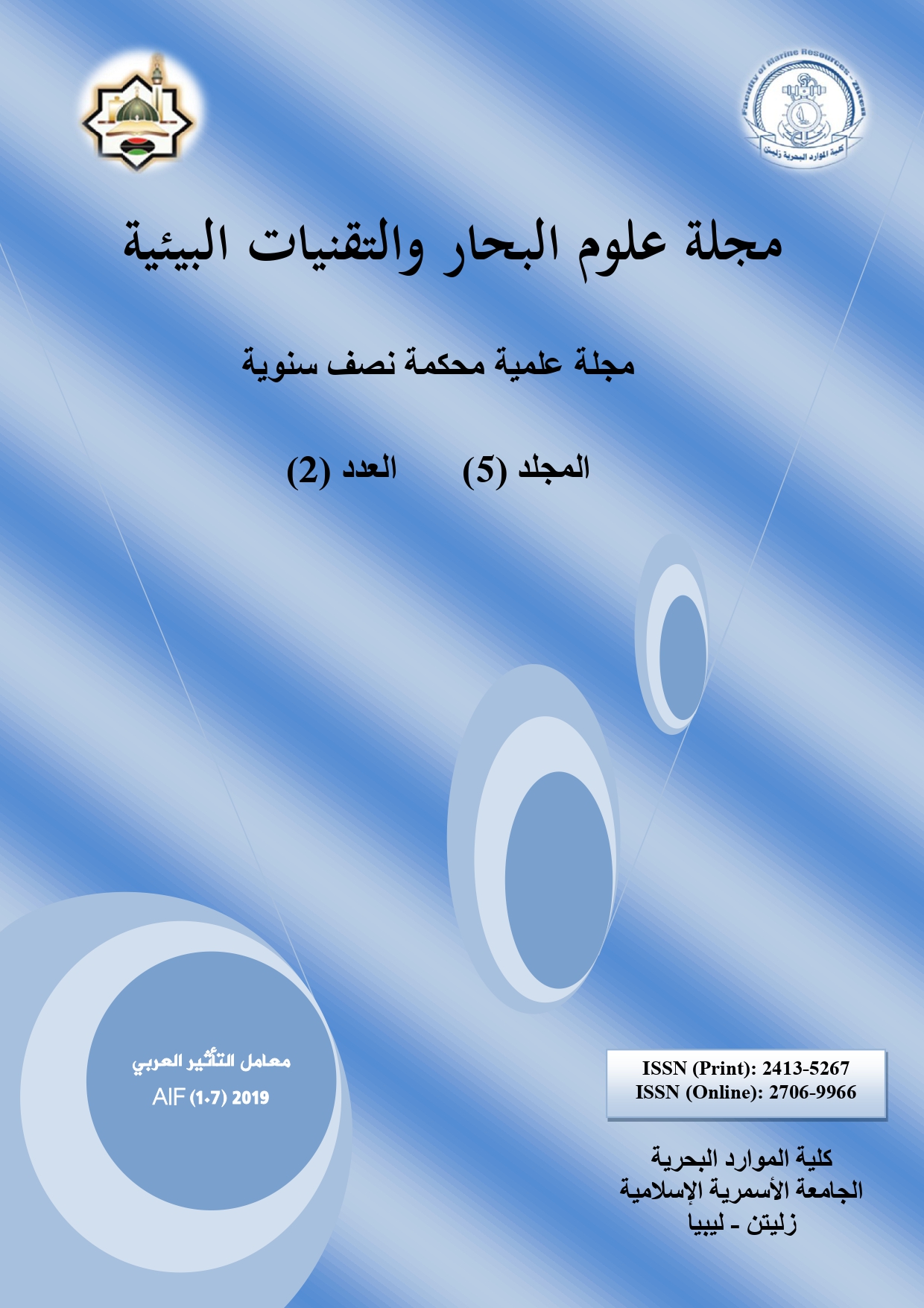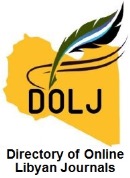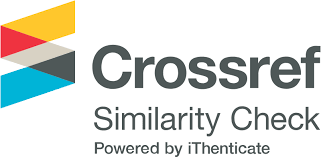دراسة العلاقة المكانية والزمانية بين صور سواتل VIIRS و LiDAR لانبعاثات ثاني أكسيد الكبريت من مصنع إسمنت المرقب في مدينة الخمس، ليبيا
DOI:
https://doi.org/10.59743/jmset.v5i2.55الكلمات المفتاحية:
VIIRS، LiDAR، انبعاثات ثاني أكسيد الكبريت، المرقب، ليبياالملخص
يمثل مصنع المرقب للإسمنت ظاهرة سلبية على البيئة بسبب انبعاثات الغازات ومن ضمنها انبعاثات أكاسيد الكبريت، استخدمت في هذه الدراسة مجموعة الإشعاع المرئي للتصوير بالأشعة تحت الحمراء (VIIRS) وبيانات القمر الصناعي LiDAR المستخدمة في هذه الدراسة لمعرفة مدى التشابه في التوزيع المكاني والزماني وكثافة انبعاثات ثاني أكسيد الكبريت. أوضحت التشابه الكبير لتوزيعات انبعاثات ثاني أكسيد الكبريت خلال مدة الدراسة من عام 2010 إلى عام 2017 لتحليل انبعاثات ثاني أكسيد الكبريت في مصنع المرقب بمدينة الخمس، ليبيا. أثبتت النتائج أن رصدات VIIRS وLiDAR توضح بدقة التباين المكاني في مركز الانبعاثات التي تميزت بعدم تجانسها كذلك في المناطق المحيطة بالمصنع وبتركيزات 0.2 إلى 1.3 طن سنويا حسب مشاهدات المتحسس LiDAR ومقارنة مع المتحسس VIIRS كانت تركيزات الانبعاثات 0.1 إلى 1.9 طن سنويا، ومقارنة تقنياتVIIRS بتحقيقات المتحسس LiDAR أكدت على وجود علاقة طردية قوية بين المتحسسين في حساب قيم تلك الانبعاثات.
التنزيلات
المراجع
Aldrich J. (2005). Fisher and regression. Statistical Science, 20(4): 401-417.
Bauer K., Thormann J, and Lohnherr L. (2009). Method of removing sulphur dioxide from cement kiln exhaust gases. Environ. Sci. Technol. J.,15: 43-92.
Bergen K.M., Goetz S.J., and Radelof V.C. (2009). Remote Sensing of vegetation 3-D structure for biodiversity and habitat: review and implications for LiDAR and radar space borne missions. J. Geophys. Res, 12:114-123.
Blonski S., Cao C., Shao X., and Uprety S. (2014). VIIRS reflective solar bands calibration changes and potential impacts on ocean color applications. In: Ocean Sensing and Monitoring VI. International Society for Optics and Photonics, 9111: 91-111.
Cao C., Xiong J., Blonski S., Liu Q., Uprety S., Shao X., Bai Y., and Weng, F. (2013). Suomi NPP VIIRS sensor data record verification, validation, and long-term performance monitoring. J. Geophys. Res., 11: 664–678.
Eckhardt S., Prata A.J., Seibert P., and Stohl A. (2008). Estimation of the vertical profile of sulfur dioxide injection into the atmosphere using satellite column measurements and inverse transport modeling. Atmos. Chem. Phys., 3: 81–97.
Eitel J., Höfle B., Vierling L.A., and Magney T.S. (2016). Beyond 3-D: The new spectrum of LiDAR applications for earth and ecological sciences. Remote Sens. Environ., 8: 372-392.
Finus M. (2003). International Cooperation to Resolve International Pollution Problems. EOLSS. J., 3(2): 112-148.
Garland C., Nibler J., and Shoemaker D. (2008). Spectroscopy in Experiments. Physical Chemistry J., 11: 28-39.
Greer W.L., Dougherty A., and Sweeney D.M. (2010). Air Pollution Engineering Manual Portland Cement, Second Edition, Editor: Davis W.T., John Wiley & Sons, Inc., New York, USA.
Hees A., Grafmüller B., Koch P., Huchler M., Croci R., Østergaard A. (2011). The GMES Sentinel-1 Antenna Model. The Netherlands J., 5(3): 18-21
Hunt W.H., and McGill M.J. (2007). Initial performance assessment of CALIOP. Geophys. Res. Lett., 3(2): 21–38.
Huntzinger D.N., and Eatmon T.D. (2009). A life-cycle assessment of Portland cement manufacturing: comparing the traditional process with alternative technologies. Journal of Cleaner Production, 17: 68–75.
Johansen V., Egelov A., and Eirikson A. (2016). Emission of NOx and SO2, From Cement Clinker Burning Installations. Zement-KalkGips NOx 10: 273.
Lefsky M.A., Cohen W.B., Parker G.G., and Harding D.J. (2002). LiDAR remote sensing for ecosystem studies. Bioscience J., 5(2): 19–30.
Lihang Z., Murty D., and Mitch G. (2019). An Overview of the Science Performances and Calibration/Validation of Joint Polar Satellite System Operational Products. Remote Sens, 11(6): 87-98.
Mateshvili N., Fussen D., Mateshvili G., Mateshvili I., Robert C., and Dekemper E. (2013). Nabro volcano aerosol in the stratosphere over Georgia, South Caucasus from ground based spectrometry of twilight sky brightness. Atmos. Meas. Tech., 6: 63–76.
Miller F.M., Young G.L., and von Seebach M. (2001). Formation and Techniques for Control of Sulfur Dioxide and Other Sulfur Compounds in Portland Cement Kiln Systems, R and D Serial, 24(2): 24-56.
Miller S., and Hansen J. (2004). Methods for reducing SO2 emissions. Cement Industry Technical Conference, IEEE-IAS/PCA: 79-92.
Pelon J., and McCormick M.P. (2003). The CALIPSO mission: Space borne lidar for observation of aerosols and clouds. Lidar Remote Sensing for Industry and Environment Monitoring. International Society for Optical Engineering, 3: 61–86.
Pugnaghi S., Gangale G., Corradini S., and Buongiorno M.F. (2006). Mt. Etna sulfur dioxide fuxmonitoring using VIIRS data and atmospheric observations. J. Volcanol. Geotherm. Res.,15(2): 74–90.
Schueler C.F., Lee T.F., and Miller S.D. (2013). VIIRS constant spatial resolution advantages. International Journal of Remote Sensing, 34: 576-577.
US Environmental Protection Agency (2005). Compilation of Air Pollutant Emission Factors. Publication AP-42. Fifth Edition. Volume I - Stationary Point and Area Sources. Research Triangle Park: 346.
Wang M., Knobelspiesse K., Charles R. (2005). Study of the Sea-Viewing Wide Field-of-View Sensor (SeaWiFS) aerosol optical property data over ocean in combination with the ocean color products. Journal of Geophysical Research-Atmospheres, 11: 69-102.
Wolfe R.E., Lin G., Nishihama M., Tewari K.P., Tilton J.C., and Isaacman A.R. (2013). Suomi NPP VIIRS prelaunch and on-orbit geometric calibration and characterization. J. Geophys. Res. Atmos, 18: 8–21.
التنزيلات
منشور
إصدار
القسم
الرخصة
الحقوق الفكرية (c) 2019 مجلة علوم البحار والتقنيات البيئية

هذا العمل مرخص بموجب Creative Commons Attribution 4.0 International License.












